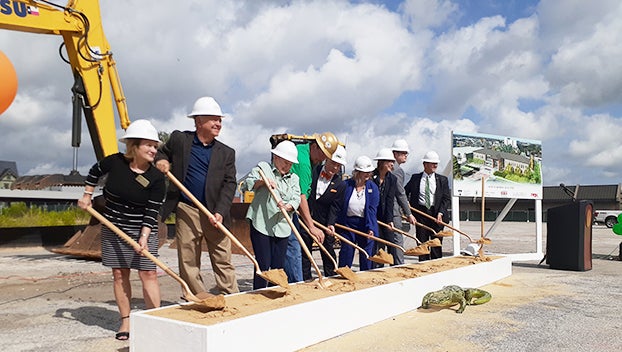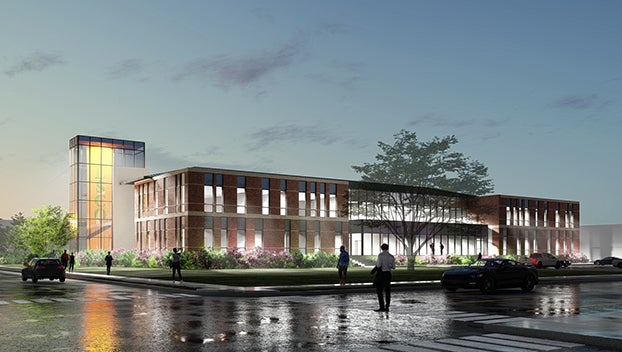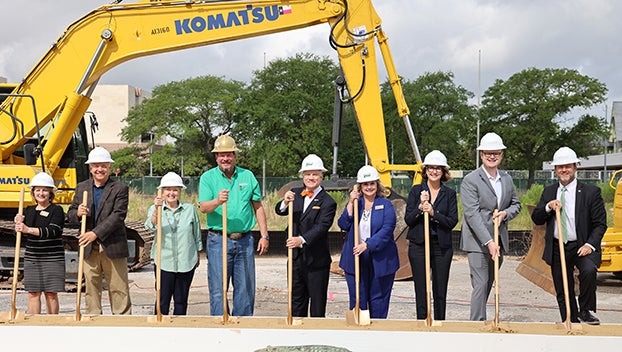Lamar State College Orange celebrates groundbreaking of new state-of-the-art Academic Building
Published 10:50 am Wednesday, April 19, 2023

- Lamar State College Orange team members and supporters celebrate the school's new Academic Building with a ceremonial ground breaking in April. (Stephen Hemelt/The Leader)
|
Getting your Trinity Audio player ready...
|
“Today, we’re here to celebrate our new 55,000-square foot academic building and starting our journey on this new state-of-the-art building.”
That was how Lamar State College Orange President Dr. Tom Johnson greeted education supporters and county leaders Wednesday morning during a groundbreaking ceremony of the school’s new Academic Building.
“When finished, this nearly $38 million building will house academic classrooms, labs and the Information Technology Department,” he said.
“We’re thrilled to break ground on this incredible new building that will provide the much needed space for our students to learn skills and concepts needed in their educational goals, whether it helps them go to work immediately or transfer to a four-year institution.”
The building is the largest single capital investment that the Texas Legislature has granted Lamar State College Orange. It is expected to open in time for the Fall 2024 semester.
The building’s funding, $37.4 million, has been provided by the Texas Legislature.
Lamar State College Orange leaders stress they are grateful for the Texas Legislature’s funding of the project, in particular Speaker Dade Phelan and State Sen. Robert Nichols.
The project construction is located at the site of the previous Capital One bank building at the southwest corner of West Green Avenue and North Fourth Street. It will sit next to LSCO’s Gatemouth Plaza, which was completed in Fall of 2021.
Helping LSCO President Dr. Tom Johnson break ground were Texas State University System Regents Stephen Lee and Sheila Faske, Cole Michalk from Speaker Dade Phelan’s office, Jennifer Harris from Senator Nichols’s office, Orange County Judge John Gothia, Gisela Houseman from the LSCO Foundation, LSCO Provost/EVP Dr. Wendy Elmore, LSCO CFO Mary Wickland, Jason Mooney from PBK Architects, and John Mixon from Durotech Contracting.

A projected view of what the new building will look like when it is finished construction. (Courtesy of Lamar State College Orange)
FEATURES
The first-floor plan includes the administrative office suites, anatomy and physiology laboratories, two classrooms, a large classroom with an operable partition, a computer laboratory, flexible laboratories and preparation spaces and building support spaces.
The second floor includes additional classrooms and computer laboratories, geology, microbiology, biology, physics and chemistry laboratories with associated preparation rooms, faculty resource areas, the Information Technology Services department suite, building support spaces and a medical privacy room.
Both floors will feature large student gathering and lobby spaces, as well as men’s and women’s restrooms. The front lobby space will be viewable via the second floor from an open concept mezzanine.

Pictured, from left, are Mary Wickland (LSCO); John Gothia (Orange County Judge); Gisela Houseman (LSCO Foundation); John Mixon (Durotech); Dr. Tom Johnson (LSCO); Dr. Wendy Elmore (LSCO); Jennifer Harris (State Senator Nichols’s Office); Cole Michalk (Speaker Phelan’s Office); and Stephen Lee (TSUS Regent). (Courtesy of Lamar State College Orange)
The second floor will open up to an approximately 730 square feet terrace, providing spectacular views along Gatemouth plaza.
The building will include a glass stair tower visible from both directions of Green Avenue, showcasing how the future of LSCO is bright orange, school officials said.
Builders
The architect/engineer for the project is PBK Architects, Inc.
The construction manager-at-risk is Durotech Inc.
According to college officials, the New Academic Building is the centerpiece of the campus.
The new building is expected to meet campus growth and improve visibility of Lamar State College Orange.
Lamar State College Orange is part of the Texas State University System. The System, founded in 1911, is Texas’s first university system. TSUS member institutions serve more than 87,000 students on 13 campuses from far West Texas to the Gulf Coast.





